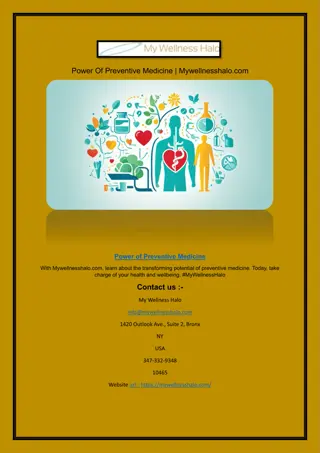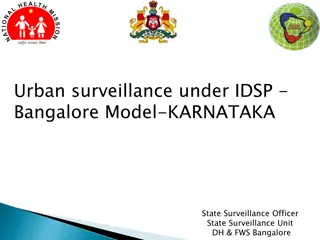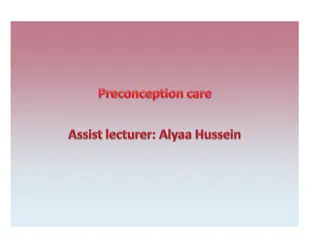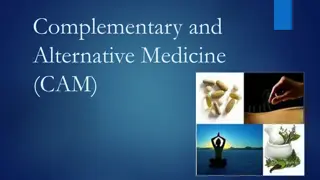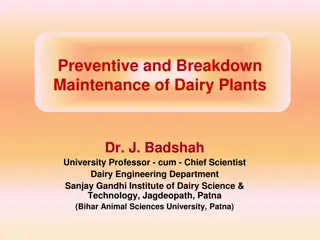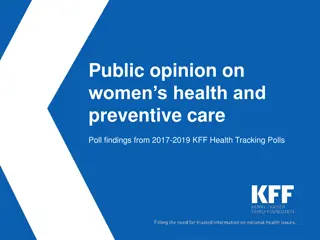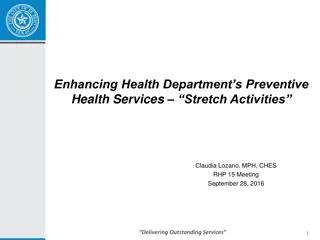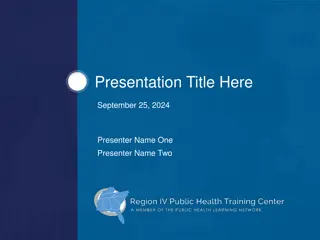Concepts in Public Health and Preventive Medicine
The evolution of nomenclature in public health, from hygiene to preventive medicine and social medicine, reflects the collective efforts to prevent disease, prolong life, and promote health. Key elements of modern public health include collective responsibility, state intervention, prevention emphasis, and understanding socio-economic determinants. Explore the dimensions of public health through preventive medicine, social medicine, community health, and community medicine, all crucial in addressing health disparities and promoting wellbeing.
Download Presentation

Please find below an Image/Link to download the presentation.
The content on the website is provided AS IS for your information and personal use only. It may not be sold, licensed, or shared on other websites without obtaining consent from the author.If you encounter any issues during the download, it is possible that the publisher has removed the file from their server.
You are allowed to download the files provided on this website for personal or commercial use, subject to the condition that they are used lawfully. All files are the property of their respective owners.
The content on the website is provided AS IS for your information and personal use only. It may not be sold, licensed, or shared on other websites without obtaining consent from the author.
E N D
Presentation Transcript
CONCEPTS IN PUBLIC HEALTH AND PREVENTIVE MEDICINE SHORT TEXTBOOK OF PUBLIC HEALTH MEDICINE FOR THE TROPICS 4th edition A d e t o k u n b o O . L u c a s dr.suzan yousif
There is a confusing in the nomenclature that is used to describe public health and its component elements. The oldest term, hygiene, embodied the early knowledge about value of sanitation and personal cleanliness. As knowledge grew, the term hygiene was felt to be too narrow and a broader term public health was used more widely. The term public health did not survive unchallenged as new terms were introduced to define special aspects of the discipline. Some used the term preventive medicine ; others preferred social medicine , community medicine , or community health . Charles-Edward Armory Winslow is a leading figure in the development of the modern study of public health. His definition of public health, developed almost a century ago, is as follows: Public health is the science and art of preventing disease, prolonging life and promoting health through the organized efforts and informed choices of society, organizations, public and private communities, and individuals. In a modern interpretation of Winslow s definition, Beaglehole and Bonita (1997) identified the following essential elements of modern public health: collective responsibility; prime role of the state in protecting and promoting the public s health; partnership with the population served; emphasis on prevention; recognizing underlying socio-economic determinants of health and disease; dr.suzan yousif
THE DIMENSIONS OF PUBLIC THE DIMENSIONS OF PUBLIC HEALTH It would be useful to explore the concepts contained in the four terms that are commonly used to describe different aspects of public health: preventive medicine; social medicine; community health; community medicine. HEALTH PREVENTIVE MEDICINE PREVENTIVE MEDICINE Prevention is better than cure is one of the prime messages of public health. It differentiates public health from the clinical disciplines that are primarily involved with the care of the sick, whilst public health emphasizes the avoidance of illness. Prevention was initially construed narrowly in terms of protective measures like vaccination and improved nutrition that target only healthy people with the aim of preventing the onset of disease. This concept was extended to cover the early diagnosis and treatment of sick persons with the aim of preventing advanced diseases and in the case of communicable diseases, in preventing the spread within the community. A further extension of the definition covers the treatment of sick individuals aimed at reversing damage and restoring function. This concept led to the classification of prevention into three levels later to be differentiated into five stages . dr.suzan yousif
SOCIAL MEDICINE SOCIAL MEDICINE The poor die young The rise of social medicine coincided with increasing realization of the links between social status and the health of individuals and communities. Statistical analyses of mortality and morbidity data show strong correlation between the social stratification in society and the pattern of health and disease. Numerous studies in many countries confirm this association and point to the need for social interventions to complement biomedical tools in improving the health of the deprived sections of the community. The objective of social medicine is to identify the social determinants of health and disease in the community and to devise mechanisms for alleviating suffering and ill health through social policies and actions. Social medicine is based on certain fundamental assumptions: Health as a birthright. Everyone has the right to enjoy the highest possible level of health. The responsibility of the state. It is the duty of governments to ensure that the people have the basic elements that would enable families and individuals to maintain good health and that they have access to good quality health care. Development and health are inter-related. Good health promotes development, and development promotes health. Education promotes health. The strong association between health and level of education is particularly marked with regard to women s education. Social factors have a profound influence on health. Culture, behaviour, social organization, allocation of family resources, healthcare seeking behaviour, etc. dr.suzan yousif
Health and human Health and human behaviour Human behaviour is an important dimension of social medicine. The link between health and human behaviour is a major area of interest in public health with medical anthropologists and sociologists providing specific professional expertise. The link between lifestyle and health is gaining more attention as chronic diseases increasingly dominate the epidemiological pattern. The risk factors associated with cancers, cardiovascular diseases, diabetes and other chronic diseases relate to such lifestyle choices as the use of tobacco and alcohol, diet, nutrition and exercise. The pandemic of HIV/AIDS has highlighted the health importance of sexual behaviour, making sex literally a matter of life and death: life in its reproductive function and death in its association with the risk of acquiring deadly diseases. behaviour Access to and utilization of Access to and utilization of health services Behavioural scientists are also interested in healthcare seeking behaviour of individuals and families ranging from the self-treatment at home, to consultations with traditional medical practitioners. Social medicine emphasizes the relationship between social factors and health status. It draws attention to the need for a multidisciplinary approach to health with deep involvement of social and behavioural scientists, economists, ethicists and political scientists. health services dr.suzan yousif
COMMUNITY HEALTH COMMUNITY HEALTH Community health deals with the services that aim at protecting the health of the community. The interventions vary from environmental sanitation including vector control to personal health care, immunization, health education and such like. It includes an important diagnostic element community diagnosis aimed at surveying and monitoring community health needs and assessing the impact of interventions. COMMUNITY MEDICINE COMMUNITY MEDICINE This usually refers to services that are provided at the community level and is now often encompassed in the new term primary care. Community physicians, nurses and other health-care personnel are involved in providing care at clinics, health centres and in people s homes. MODERN PUBLIC HEALTH MODERN PUBLIC HEALTH The modern concept of public health includes all these elements preventive medicine, social medicine, community medicine, community health. Important features of modern public health include the following characteristic features. It is: multidisciplinary; multisectoral; evidence-based; equity-oriented. dr.suzan yousif
MULTIDISCIPLINARY MULTIDISCIPLINARY Although medical practitioners constitute a vital segment of the public health practitioners, the contributions from other health-related disciplines are absolutely essential for achieving the goals of public health. Thus, the public health team would include, as required, doctors, nurses, midwives, dentists and pharmacists; anthropologists, economists and other social scientists; philosophers, ethicists and other experts on moral sciences, as well as educationists, communications experts and managers MULTISECTORAL MULTISECTORAL The health sector has two distinct roles. It is primarily responsible for planning and delivering health services. It also has an important leadership function in mobilizing intersectoral action. It should work with other ministries: with public works on water and sanitation; with education on the health of school children and health promotion; with transport on the control of road traffic accidents; and with agriculture on food security, nutrition, use of pesticides and the control of zoonotic infections. EVIDENCE EVIDENCE- -BASED Modern public health demands that decisions should be science-based and knowledge-based. As far as possible, policy-making should be made only after objective analysis of relevant information. Where information is lacking, there is a clear indication for gathering data and carrying out research to inform decision-making. It is often stated that researchers should present their results in a way that decision-makers can apply their findings. By the same token, policy-makers have the responsibility to ensure that their decisions are based on the best available scientific evidence. Both researchers and policy-makers with their common interest in promoting the health of the population need to work closely together in generating and using sound evidence as the basis of decision-making. BASED dr.suzan yousif
EQUITY EQUITY- -ORIENTED ORIENTED Public health programmes must be designed to promote equity as the ultimate goal of all health action. The aim is to ensure for each member of society the highest possible level of health. Public health programmes should actively monitor equity and make necessary corrections. Public health practitioners must adopt a strong advocacy role in persuading decision-makers and influential members of society that, in the long run, equity in health is to everyone s advantage as a means of securing sustainable development and strengthening the social contract among citizens from a wide variety of backgrounds and between them and their governments. It should be made clear that solidarity with the poor is not merely an act of charity but a mechanism for promoting the welfare of all peoples. KEY PUBLIC HEALTH FUNCTIONS KEY PUBLIC HEALTH FUNCTIONS Public health services perform a wide range of functions, which can be classified as four key elements: assessing and monitoring of the health of the population; planning, implementing and evaluating public health programmes; identifying and dealing with environmental hazards; communicating with people and organizations to promote public health dr.suzan yousif
THE TROPICAL ENVIRONMENT THE TROPICAL ENVIRONMENT The total environment of human beings includes all the living and non- living elements in their surroundings. It consists of three major components: physical, biological and social. The relationships of human beings to their environment is reciprocal in that the environment has a profound influence on them and they in turn make extensive alterations to the environment to meet their needs and desires. PHYSICAL ENVIRONMENT PHYSICAL ENVIRONMENT This refers to the non-living part of the environment air, soil, water, minerals and climatic factors such as temperature and humidity. The physical environment is extremely variable in the tropics covering deserts, savannahs, upland jungle, cold dry or humid plateaux, marshlands, high mountain steppes or tropical rainforest. Climatic factors such as temperature and humidity have a direct effect on humans, their comfort and their physical performance. The physical environment also exerts an indirect effect by determining the distribution of organisms in the biological environment: plants and animals which provide food, clothing and shelter; animals which compete with humans for food; and parasites and their vectors which produce and transmit disease. Humans alter the natural characteristics of the physical environment sometimes on a small scale but often on a very large scale: from clearing a small patch of bush, building a hut and digging a small canal to irrigate a vegetable garden to the building of large cities, draining of swamps, irrigating arid zones, damming rivers and creating large artificial lakes. Many such changes have proved beneficial but some aspects of these changes have created new hazards. dr.suzan yousif
BIOLOGICAL ENVIRONMENT BIOLOGICAL ENVIRONMENT All the living things in an area plants, animals and micro-organisms constitute the biological environment. They are dependent on each other and ultimately, on their physical environment. Thus, nitrogen-fixing organisms convert atmospheric nitrogen into the nitrates that are essential for plant life. Plants trap energy from the sun by photosynthesis. A mammal may obtain its nourishment by feeding on plants (herbivore) or on other animals (carnivore) or both (omnivore). Under natural conditions, there is a balanced relationship between the growth and the size of the population of a particular species, on the one hand, and its sources of food and prevalence of competitors and predators, on the other hand. Humans deliberately manipulate the biological environment by cultivating useful plants to provide food, clothing and shelter, and raising farm animals for their meat, milk, leather, wool and other useful products. They hunt and kill wild animals, and destroy insects which transmit disease or which compete with them for food. In many parts of the tropics, insects, snails and other vectors of disease abound and thrive. This is partly because the natural environment favours their survival but also because, in some of these areas, relatively little has been done to control these agents. SOCIAL ENVIRONMENT SOCIAL ENVIRONMENT This is the part of the environment that is entirely made by humans. In essence, it represents the situation of human beings as members of society: family groups, village or urban communities, culture including beliefs and attitudes, the organization of society politics and government, laws and the judicial system, the educational system, transport and communication, and social services including health care. dr.suzan yousif
HEALTH AND DEVELOPMENT HEALTH AND DEVELOPMENT The close link between health and development in other sectors is clearly recognizable. There is a clear correlation between economic, industrial and other indices of development and the health status of populations and communities. At one end of the spectrum are the industrialized, affluent developed countries and at the other end are the least developed countries that still rely largely on traditional agricultural practices and simple crafts. The term developing countries is used to describe countries that have not as yet achieved a high level of industrial and economic development. Characteristic features of developing countries include relatively low income, low literacy rates, low access to electricity and other modern sources of energy, and high mortality rates among vulnerable groups (children, pregnant women). These factors interact: illiteracy is associated with poverty; poverty predisposes to ill health; and ill health aggravates poverty. dr.suzan yousif
There is much variation in the extent of technical development in the various countries in the tropics. Some of these countries are now highly developed whilst others are still in the early stages. Some of the developing countries show certain common features: limited central organization of services, scattered populations living in small self-contained units, low level of economic development, limited educational facilities, and inadequate control of common agents of disease. Some of these communities are still held tightly in the vicious circle of ignorance, poverty and disease. Rapid economic development and the growth of modern industries are causing mass migrations from rural to urban areas. Faster means of transportation, progress in education, the control and eradication of major endemic diseases, and other developments are effectively breaking the chains of disease, poverty and ignorance. At the same time new problems are emerging, including those resulting from the social and psychological stresses imposed by these bewildering changes and their destructive effects on traditional family life and communal relationships. In these transitional societies there have been marked changes in the patterns of disease. Noncommunicable diseases and conditions are now replacing communicable diseases which were formerly the predominant causes of disability, disease and death. Malnutrition in the form of the deficiency of specific nutrients is being succeeded by problems resulting from over-indulgence, thus obesity is replacing marasmus as the predominant nutritional problem. Alcoholism and drug abuse are emerging as manifestations of social stresses and tensions dr.suzan yousif
T TTHE ECOLOGICAL APPROACH THE ECOLOGICAL APPROACH TO PUBLIC HEALTH In public health, it is useful to consider the reciprocal relationship between humans and their total environment. In the search for the causes of disease, it is not sufficient merely to identify the specific agent of a disease, such as a virus or a parasite, but it is desirable to identify the influence of environmental factors on the interaction between humans and the specific agent. For example, the typhoid bacillus (Salmonella typhi) is known to be the causative agent of disease but the occurrence of outbreaks of typhoid is determined by various environmental factors: water supply, methods of sewage disposal, prevalence of typhoid carriers, personal habits of the people (cleanliness), use of raw water, attitude to and use of medical services, including vaccination. Similarly, a specific nutritional deficiency, such as ariboflavinosis, should not be viewed merely as a discrete metabolic defect but it should be seen in the context of the food habits of the community including food taboos, the level of education and income of the population and the local agriculture. From this ecological approach, one can derive a rational basis for the control of disease within the population. Typhoid control should go beyond the treatment of the individual patient, to include immunization of susceptible groups, protection of water supplies, safe disposal of waste and improvement of personal hygiene. Malnutrition is managed not only by giving pills containing concentrated nutrients but also by giving suitable advice about diet and promoting the cultivation of nutritional foods both commercially by farmers and privately in home gardens; in more complex situations management may extend to promotion of welfare services such as unemployment benefits and food supplements for the needy. TO PUBLIC HEALTHO PUBLIC HEALTH O PUBLIC HEALTH dr.suzan yousif
The health worker should seek suitable opportunities for improving the health of the people through action on the environment. It is important that these lessons should be repeatedly emphasized. The individual and the family can do much about the cleanliness of the home and its immediate surroundings, thereby reducing the occurrence of a number of infectious diseases. Domestic accidents, especially in such high-risk areas as the kitchen and the bathroom, can be prevented by careful attention to the environment in the home. The individual needs to recognize how the environment in the home affects the health of the family, why each person must act to improve the situation and what the individual and the family can do to deal with the problem. The community should be approached as a whole to deal with the widespread problems that affect many families, and also for help with those problems which require action beyond the means of individual families. For example, certain environmental situations may require organization at the community level and must be designed in the context of the culture of the local community: collection and storage of water to ensure that each family has an adequate supply of safe water; disposal of human and other wastes; control of other environmental hazards. In most developing countries, modern development projects and urbanization are introducing new risks . It is therefore necessary to ensure that these new initiatives should be carefully examined at the community level with regard to their appropriate siting and safe management, with minimal risk to the environment. At the national and international level, large-scale projects such as the creation of artificial lakes, irrigation projects and mining of minerals including oil, require careful assessment of their environmental impact. The adverse effects can best be minimized by careful planning so that as far as possible protective measures can be incorporated into the design of these projects. dr.suzan yousif
Some developed countries facing problems of disposing of toxic chemicals and radioactive waste have resorted to dumping them in developing countries. The serious concerns raised by these events should lead to tighter international controls. Developing countries are also involved in dealing with environmental issues which are of global dimensions: the denudation of the tropical forest and its probable adverse effects on climate; the use of chlorofluorocarbons (CFCs) that destroy the ozone layer; and the extensive use of fossil fuel and consequent increase in greenhouse gases identified as the main cause of global warming. dr.suzan yousif







